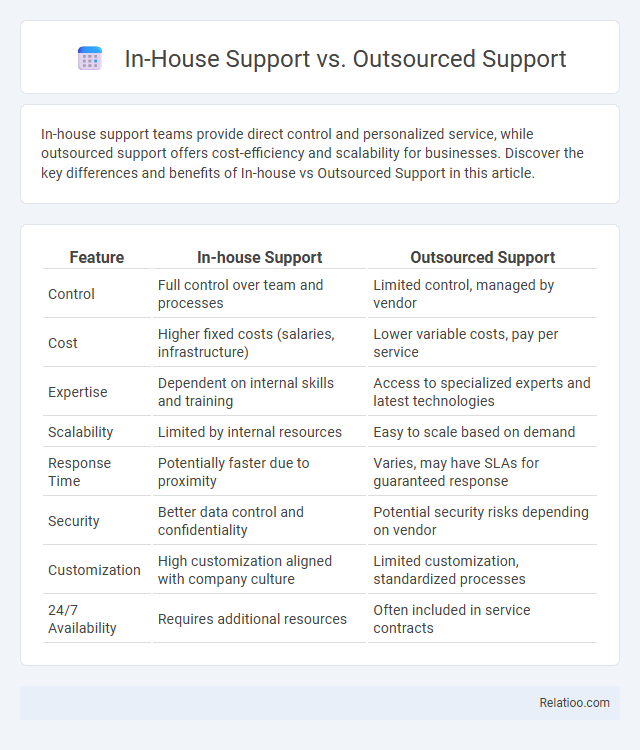In-house support teams provide direct control and personalized service, while outsourced support offers cost-efficiency and scalability for businesses. Discover the key differences and benefits of In-house vs Outsourced Support in this article.
Table of Comparison
| Feature | In-house Support | Outsourced Support |
|---|---|---|
| Control | Full control over team and processes | Limited control, managed by vendor |
| Cost | Higher fixed costs (salaries, infrastructure) | Lower variable costs, pay per service |
| Expertise | Dependent on internal skills and training | Access to specialized experts and latest technologies |
| Scalability | Limited by internal resources | Easy to scale based on demand |
| Response Time | Potentially faster due to proximity | Varies, may have SLAs for guaranteed response |
| Security | Better data control and confidentiality | Potential security risks depending on vendor |
| Customization | High customization aligned with company culture | Limited customization, standardized processes |
| 24/7 Availability | Requires additional resources | Often included in service contracts |
Introduction to In-house and Outsourced Support
In-house support involves a dedicated team within your organization handling IT issues, providing faster response times and deeper system knowledge tailored to your business needs. Outsourced support relies on external vendors offering specialized expertise and scalable services, often at a lower cost but with potential communication delays. Choosing between these models affects operational efficiency, budget allocation, and control over your IT infrastructure.
Key Differences Between In-house and Outsourced Support
In-house support offers direct control and immediate access to a dedicated team familiar with company-specific systems, enhancing customization and security. Outsourced support provides cost efficiency and scalability by leveraging external expertise, but may face challenges in communication and slower response times. Key differences revolve around control, cost, flexibility, and the level of integration with company culture and processes.
Cost Comparison: In-house vs Outsourced Support
In-house support typically incurs higher fixed costs due to salaries, benefits, training, and infrastructure, while outsourced support offers variable expenses based on service agreements and usage levels. Outsourced support reduces overhead by leveraging external expertise and economies of scale, often resulting in lower total cost of ownership for IT support functions. Businesses must weigh the predictable cost structure of in-house teams against the flexibility and potential cost savings of outsourced providers when evaluating support strategies.
Control and Flexibility Considerations
In-house support offers maximum control over processes and direct oversight of staff performance, enabling rapid adjustments aligned with company goals. Outsourced support provides greater flexibility in scaling resources up or down without the administrative burden, but may sacrifice some control due to external management and standardized service agreements. Resource allocation decisions must balance the need for tailored control with operational agility, considering factors such as response time requirements, customization needs, and available internal expertise.
Scalability and Resource Allocation
In-house support offers direct control over resource allocation but often faces limitations in scalability due to fixed staffing and infrastructure costs. Outsourced support provides flexible scalability by allowing businesses to adjust service levels and resources on demand, optimizing operational expenses. Hybrid models combining in-house and outsourced resources enable balanced resource allocation, ensuring scalability while maintaining core expertise internally.
Talent and Expertise Availability
In-house support ensures direct access to specialized talent familiar with your company's culture and systems, offering immediate expertise tailored to your unique needs. Outsourced support provides scalable access to a diverse pool of external experts, often delivering cost-effective solutions with specialized skills that may not be available internally. Your choice impacts the availability and depth of talent, balancing control and flexibility to optimize operational efficiency.
Quality Assurance and Performance Metrics
In-house support teams deliver higher quality assurance through direct oversight, alignment with company standards, and immediate feedback loops, resulting in improved performance metrics like first-call resolution and customer satisfaction scores. Outsourced support often offers cost efficiency and scalability but may experience inconsistent quality assurance due to varied training levels and less direct control over performance management. Resource allocation impacts performance metrics significantly; dedicated in-house resources typically achieve better response times and resolution rates, while outsourced or hybrid models risk variability without rigorous SLA and KPI monitoring frameworks.
Security and Data Privacy Implications
In-house support offers greater control over security protocols and data privacy measures, ensuring that sensitive information remains within your organization's direct supervision. Outsourced support requires rigorous vendor vetting and compliance checks to mitigate risks related to third-party access and potential breaches. Choosing the right resource impacts how effectively your company can enforce data protection policies and respond to security incidents.
Business Continuity and Risk Management
In-house support ensures direct control over IT operations, enhancing business continuity through immediate issue resolution and tailored risk management strategies. Outsourced support offers scalability and specialized expertise, reducing operational risks by leveraging external risk mitigation frameworks and disaster recovery plans. Resource allocation between in-house and outsourced models balances cost efficiency with strategic risk oversight, supporting sustained business operations and resilience against disruptions.
Making the Right Choice for Your Business
Choosing between in-house support, outsourced support, and resource allocation depends on factors such as cost efficiency, control over processes, and scalability needs. In-house support provides direct oversight and better integration with company culture, while outsourced support offers cost savings and access to specialized expertise. Evaluating business size, budget constraints, and long-term growth plans ensures selecting the right support model that aligns with operational goals and customer satisfaction priorities.

Infographic: In-house Support vs Outsourced Support
 relatioo.com
relatioo.com